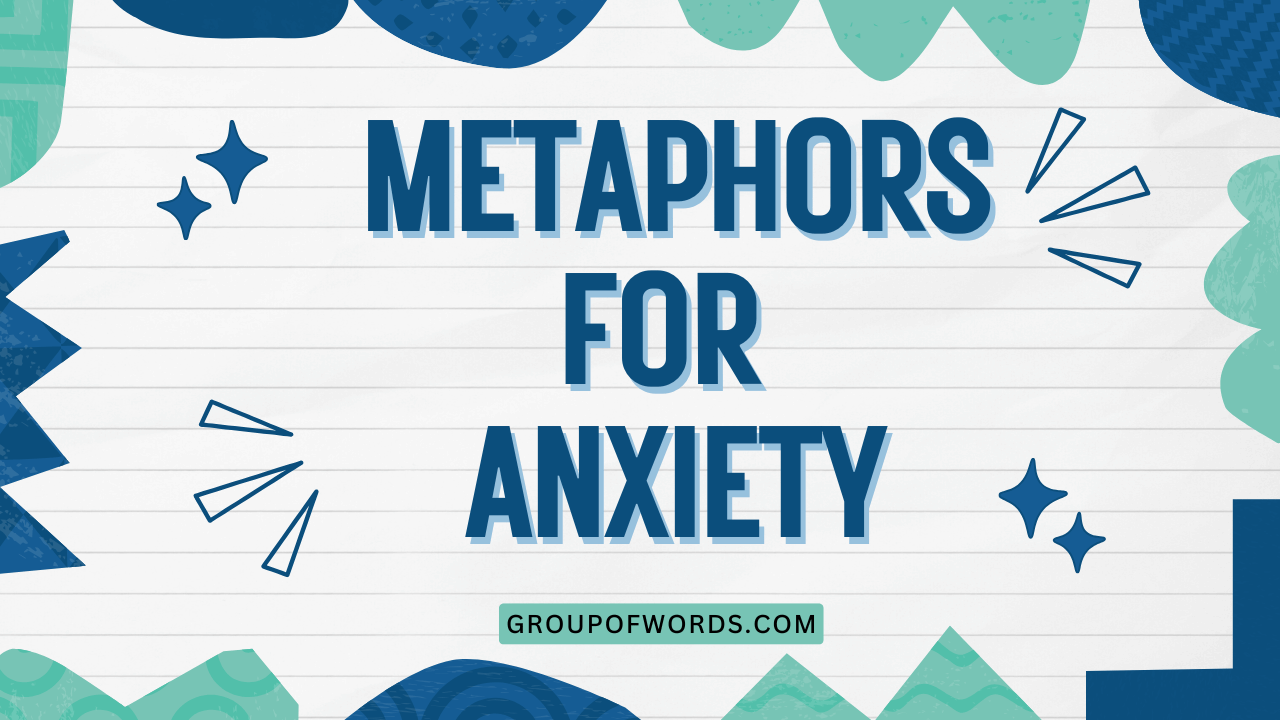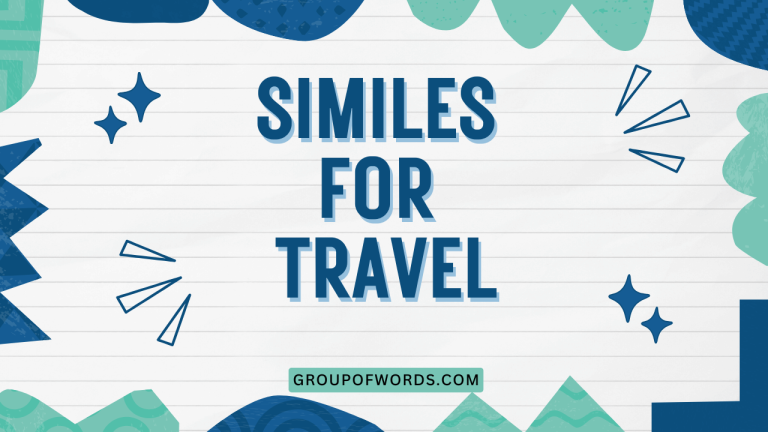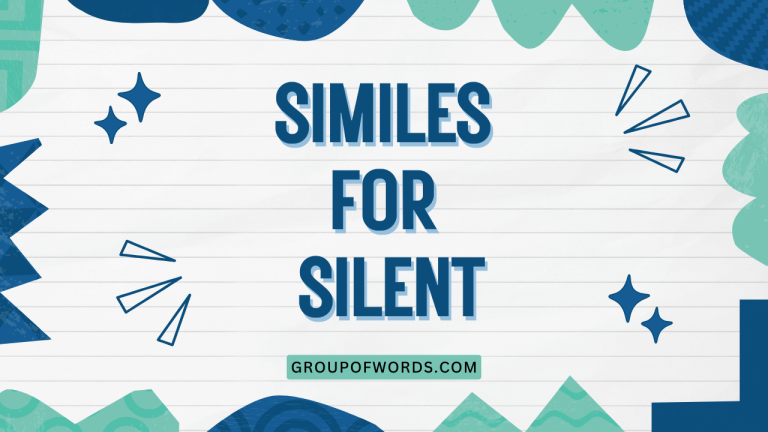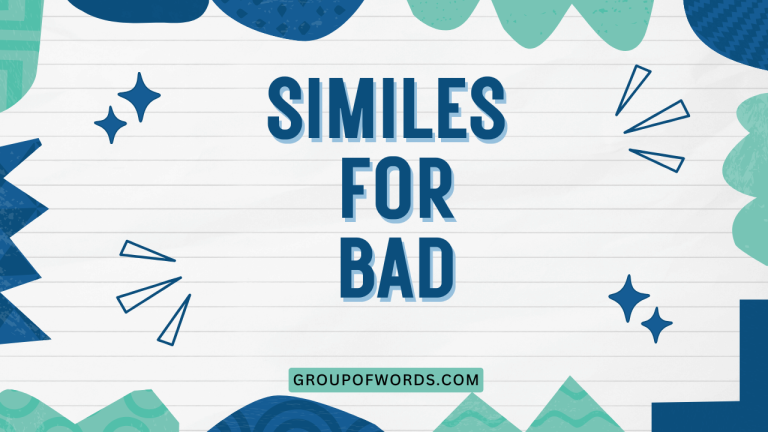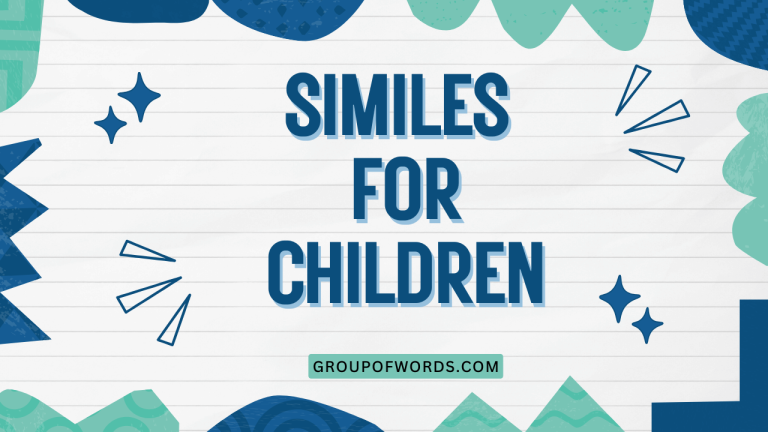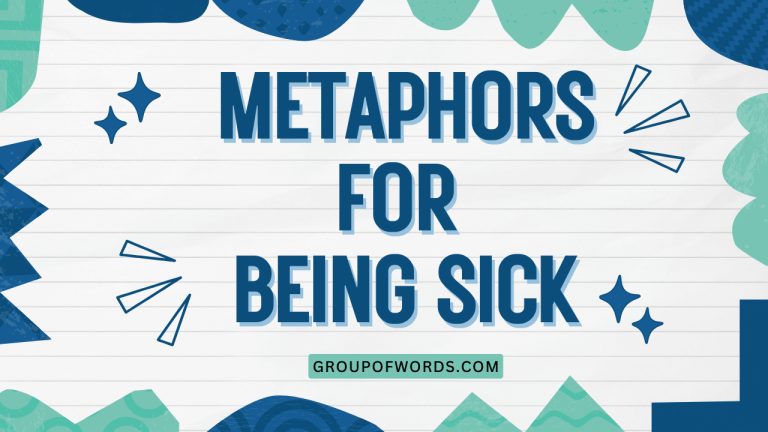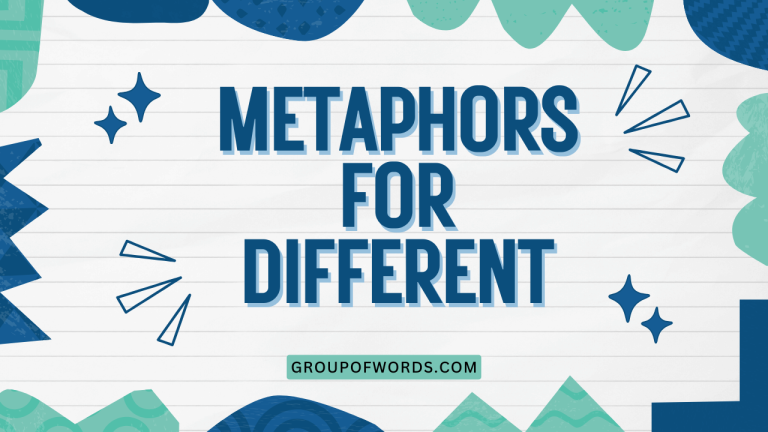Unveiling Anxiety: Mastering the Art of Metaphorical Expression
Anxiety, a pervasive emotion in modern life, often eludes direct description. It’s a complex blend of unease, fear, and apprehension that can be difficult to articulate.
This article explores the powerful tool of metaphors for expressing and understanding anxiety. By examining various metaphorical representations, we can gain deeper insights into this often-debilitating condition.
This guide is designed for English language learners, writers, and anyone seeking to better understand and communicate about anxiety.
Metaphors are essential in English grammar and rhetoric. They allow us to convey abstract concepts by relating them to more concrete, relatable ideas.
Understanding how to use metaphors effectively enhances communication skills and adds depth to writing. This article provides a structured approach to using metaphors for anxiety, complete with examples, exercises, and practical tips.
Table of Contents
- Introduction
- Defining Anxiety Through Metaphor
- Structural Breakdown of Anxiety Metaphors
- Types of Metaphors for Anxiety
- Examples of Anxiety Metaphors
- Usage Rules for Anxiety Metaphors
- Common Mistakes with Anxiety Metaphors
- Practice Exercises
- Advanced Topics in Metaphorical Representation of Anxiety
- Frequently Asked Questions
- Conclusion
Defining Anxiety Through Metaphor
Anxiety, in its essence, is a feeling of worry, nervousness, or unease, typically about an imminent event or something with an uncertain outcome. It can manifest physically, emotionally, and behaviorally.
Because anxiety is an internal experience, metaphors provide a powerful way to externalize and communicate its nature. A metaphor, in this context, serves as a figure of speech that directly refers to one thing by mentioning another for rhetorical effect.
It allows us to understand the abstract feeling of anxiety by comparing it to something more tangible and relatable. This comparison helps both the person experiencing anxiety and their audience to grasp the intensity and impact of the emotion.
Consider the metaphor “Anxiety is a storm.” Here, anxiety (the subject) is being equated to a storm (the vehicle). The shared characteristics might include a sense of overwhelming force, unpredictability, and potential for damage.
This metaphorical representation helps convey the intensity and disruptive nature of anxiety more effectively than a simple definition.
Structural Breakdown of Anxiety Metaphors
Anxiety metaphors typically follow a basic structure: Anxiety is X, where X is a more concrete or relatable concept. This structure can be expanded to include descriptive details that enhance the metaphor’s impact. Understanding the structural elements can help you create more vivid and effective metaphors.
Let’s break down the components:
- The Subject: This is the concept being explained – in this case, anxiety.
- The Vehicle: This is the object, concept, or image used to represent anxiety. Examples include storms, weights, animals, or machines.
- The Ground: This refers to the shared characteristics between the subject and the vehicle. These are the points of similarity that make the metaphor effective. For example, the ground between “anxiety” and “storm” might include feelings of being overwhelmed, a lack of control, and potential for disruption.
By carefully selecting the vehicle and highlighting the ground, you can create metaphors that resonate with your audience and accurately reflect the experience of anxiety. The effectiveness of a metaphor depends on how well the audience understands the vehicle and can relate it to the feeling of anxiety.
Types of Metaphors for Anxiety
Anxiety can be represented through various types of metaphors, each offering a unique perspective on the experience. Understanding these different types allows for more nuanced and descriptive communication.
Anxiety as Weather
This is one of the most common types of metaphors for anxiety. Weather is unpredictable, powerful, and can significantly impact our environment and mood.
Comparing anxiety to weather highlights its overwhelming and uncontrollable nature. Phrases such as “a storm of anxiety” or “clouds of worry” are frequently used to describe the experience.
Anxiety as Weight
This type of metaphor emphasizes the burden and pressure that anxiety can place on a person. The feeling of being weighed down, both physically and mentally, is a common symptom of anxiety.
Metaphors like “the weight of worry” or “a heavy heart” effectively convey this sense of burden.
Anxiety as an Animal
Animals can represent different aspects of anxiety, such as fear, restlessness, or aggression. For example, anxiety might be described as a “caged tiger” to represent pent-up energy and agitation, or a “nervous mouse” to represent fear and vulnerability.
The specific animal chosen can significantly impact the metaphor’s meaning.
Anxiety as an Obstacle
This type of metaphor portrays anxiety as something that blocks progress or prevents a person from achieving their goals. Phrases like “anxiety is a wall” or “a roadblock to success” illustrate the hindering effect of anxiety.
This metaphor highlights the frustration and limitations that anxiety can impose.
Anxiety as Machinery
This metaphor compares anxiety to a malfunctioning machine, emphasizing the feeling of being out of control and overwhelmed by internal processes. Phrases like “my mind is a runaway train” or “my thoughts are stuck in overdrive” capture the sense of mental chaos and inability to switch off.
Examples of Anxiety Metaphors
The following tables provide numerous examples of metaphors for anxiety, categorized by type. Each example is designed to illustrate how different vehicles can be used to represent the experience of anxiety.
The table below shows examples of anxiety metaphors using weather as the vehicle. Note how each example conveys different levels and aspects of anxiety.
| Metaphor | Explanation |
|---|---|
| A storm of anxiety raged within me. | Describes an intense and overwhelming experience of anxiety. |
| Clouds of worry darkened my thoughts. | Indicates a pervasive and gloomy sense of anxiety. |
| The anxiety was a constant drizzle, never truly stopping. | Represents a persistent and low-level form of anxiety. |
| I felt the tremors of an impending anxiety earthquake. | Suggests a powerful and destructive wave of anxiety is about to hit. |
| My mind was caught in a hurricane of panic. | Captures the chaotic and uncontrollable nature of a panic attack. |
| Anxiety was a fog, obscuring my path forward. | Implies confusion and uncertainty caused by anxiety. |
| The sunny day was overshadowed by a sudden squall of anxiety. | Illustrates how anxiety can unexpectedly disrupt moments of peace. |
| I was drowning in a sea of anxious thoughts. | Conveys the feeling of being overwhelmed and suffocated by anxiety. |
| A blizzard of fear swept through my body. | Describes an intense and chilling experience of fear and anxiety. |
| The anxiety was a heatwave, making me restless and irritable. | Represents a burning and uncomfortable feeling of anxiety. |
| A gentle breeze of worry stirred in my mind. | Indicates a mild and subtle presence of anxiety. |
| The pressure of anxiety felt like a gathering storm. | Suggests that anxiety is building up to a critical point. |
| I was trapped in a cyclone of anxious thoughts. | Emphasizes the repetitive and inescapable nature of anxious thinking. |
| The sky of my mind was filled with thunderous anxiety. | Captures the loud and intimidating aspect of anxiety. |
| A light shower of nervousness sprinkled my day. | Represents a minor and fleeting experience of anxiety. |
| The anxiety was a persistent chill, seeping into my bones. | Describes a deep and penetrating sense of unease. |
| I felt like I was standing in the eye of the anxiety storm, waiting for it to pass. | Conveys the feeling of being temporarily spared from the full force of anxiety. |
| The weather forecast in my mind predicted a week of relentless anxiety. | Illustrates the anticipation and dread of prolonged anxiety. |
| A downpour of worry flooded my senses. | Describes an overwhelming sensory experience of anxiety. |
| The anxiety was a stifling humidity, making it hard to breathe. | Represents the suffocating and oppressive nature of anxiety. |
| Dark clouds of fear gathered on the horizon of my mind. | Suggests an impending sense of doom and anxiety. |
| My thoughts were tossed and turned like leaves in a whirlwind of anxiety. | Captures the feeling of mental disarray and lack of control. |
| The anxiety was a constant static in the background of my mind, like the hum before a thunderstorm. | Represents a subtle but persistent undercurrent of anxiety. |
| I was caught in a relentless hailstorm of self-doubt and worry. | Describes a barrage of negative thoughts and anxieties. |
| The anxiety felt like a sudden drop in temperature, leaving me cold and shaken. | Conveys the feeling of being abruptly overwhelmed by anxiety. |
The following table illustrates how anxiety can be metaphorically represented as a weight, emphasizing the burden and pressure it creates.
| Metaphor | Explanation |
|---|---|
| The weight of worry pressed down on my chest. | Describes the physical sensation of pressure and heaviness caused by anxiety. |
| Anxiety was a heavy burden I carried everywhere. | Represents the constant and inescapable nature of anxiety. |
| I felt crushed under the weight of my anxious thoughts. | Conveys the feeling of being overwhelmed and incapacitated by anxiety. |
| The anxiety was a lead weight in my stomach. | Describes the physical discomfort and unease caused by anxiety. |
| I struggled to shrug off the weight of my fears. | Illustrates the difficulty of letting go of anxious thoughts. |
| Anxiety was an anchor, holding me back from progress. | Represents the hindering effect of anxiety on personal growth. |
| The weight of expectations fueled my anxiety. | Suggests that external pressures contribute to the feeling of anxiety. |
| I felt like I was carrying the weight of the world on my shoulders. | Conveys an overwhelming sense of responsibility and pressure. |
| The anxiety was a backpack full of stones, weighing me down. | Represents the cumulative effect of anxious thoughts and worries. |
| I felt the immense weight of responsibility amplifying my anxiety. | Describes how responsibility intensifies anxiety levels. |
| The pressure of anxiety felt like a building slowly crushing me. | Illustrates the slow, persistent, and overwhelming feeling of dread. |
| Every worry was a brick added to the wall of my anxiety. | Represents how cumulative worries can build up and create a barrier. |
| I was sinking under the weight of my anxieties, unable to resurface. | Conveys a feeling of helplessness and being overwhelmed. |
| The burden of my anxiety felt like carrying a mountain on my back. | Emphasizes the massive and unmanageable nature of anxiety. |
| It’s as if anxiety is a constant extra weight I have to carry around with me, slowing me down. | Represents the ongoing and energy-draining impact of anxiety. |
| My anxiety is a heavy cloak, always there, restricting my movements and keeping me from feeling light. | Illustrates restriction and lack of freedom caused by anxiety. |
| The weight of their expectations became an unbearable burden on my anxious heart. | Conveys how external pressures can exacerbate anxiety. |
| The anxiety I felt was like a physical weight pressing down on my spirit, making it hard to breathe. | Describes the suffocating and physically restricting sensation of anxiety. |
| Each fear I faced added another pound to the heavy load of my anxiety. | Represents how confronting fears can still contribute to the overall weight of anxiety. |
| My anxiety feels like an invisible weight, only I can feel its crushing presence. | Illustrates the isolating experience of anxiety, felt internally and unseen by others. |
| The past trauma was like a heavy chain, dragging me down into the depths of anxiety. | Symbolizes how past experiences can continue to burden and cause anxiety. |
| Anxiety felt like wearing shoes filled with concrete, making every step exhausting and strained. | Represents the tiring and difficult journey through life with anxiety. |
| The constant pressure to succeed added more weight to my already heavy load of anxiety. | Describes how societal pressures can intensify anxiety. |
| I was drowning, weighed down by the anchors of my past regrets and future worries. | Illustrates how past and future anxieties can combine to create an overwhelming burden. |
| The anxiety was a gravitational pull dragging me towards the black hole of despair. | Conveys the intense feeling of being drawn into a negative and hopeless state. |
This table provides examples of metaphors that use animals to represent anxiety, highlighting different aspects such as fear, aggression, or restlessness.
| Metaphor | Explanation |
|---|---|
| Anxiety was a caged tiger, pacing restlessly within me. | Represents the pent-up energy and agitation associated with anxiety. |
| I felt like a nervous mouse, scurrying away from every perceived threat. | Conveys the feeling of fear and vulnerability. |
| Anxiety was a venomous snake, coiling around my heart. | Describes the insidious and harmful nature of anxiety. |
| My thoughts were like a swarm of bees, buzzing frantically in my mind. | Represents the chaotic and overwhelming nature of anxious thoughts. |
| Anxiety was a hawk, circling overhead, waiting to strike. | Illustrates the constant sense of impending doom. |
| I felt like a trapped bird, desperately trying to escape my anxious thoughts. | Conveys the feeling of being confined and unable to break free. |
| Anxiety was a relentless dog, nipping at my heels. | Represents the persistent and irritating nature of anxiety. |
| My mind was a restless hummingbird, flitting from one worry to the next. | Describes the inability to focus and the constant shifting of anxious thoughts. |
| Anxiety was like a shadow, a constant wolf following me, always there and never truly gone. | Represents the ever-present and lurking nature of anxiety. |
| The anxiety felt like having a swarm of wasps trapped inside my chest, buzzing and stinging relentlessly. | Describes the painful and irritating sensation of anxiety. |
| My anxious thoughts multiplied like rabbits, overwhelming me with their sheer numbers. | Illustrates the rapid and uncontrollable proliferation of anxious thoughts. |
| Anxiety was a spider, weaving a web of fear around me, trapping me in its sticky threads. | Represents the feeling of being ensnared and controlled by anxiety. |
| I felt like a cornered rat, desperate and terrified, with no escape from my anxiety. | Conveys a sense of panic and being trapped with no options. |
| The anxiety was an owl, silently watching and waiting for me to make a mistake. | Represents the feeling of being constantly scrutinized and judged. |
| My heart raced like a hummingbird’s wings, fueled by the adrenaline of my anxiety. | Describes the physical manifestation of anxiety through a racing heart. |
| Anxiety felt like being chased by a pack of wolves, relentless and terrifying. | Illustrates the feeling of being pursued and overwhelmed by anxiety. |
| My mind was like a beehive, buzzing with the constant activity of anxious thoughts. | Represents the chaotic and busy nature of an anxious mind. |
| The anxiety was a parasitic leech, feeding off my energy and leaving me drained and exhausted. | Describes the energy-sapping and draining effect of anxiety. |
| Like a scared turtle, I retreated into my shell, trying to hide from the overwhelming anxiety. | Represents the instinct to withdraw and isolate oneself when feeling anxious. |
| The anxiety was a caged bird, desperately trying to escape the confines of my mind. | Conveys the feeling of being trapped and wanting to break free from anxiety. |
| My thoughts were like a flock of crows, cawing and creating a cacophony of negativity. | Represents the loud and overwhelming nature of negative thoughts. |
| The anxiety was a restless horse, constantly prancing and never allowing me to find peace. | Illustrates the inability to relax and the constant restlessness of anxiety. |
| I felt like a small fish in a tank full of sharks, constantly on edge and fearing the next attack of anxiety. | Conveys the feeling of vulnerability and constant threat. |
| Like a moth to a flame, I was drawn to the things that triggered my anxiety, even though I knew they would hurt me. | Represents the paradoxical attraction to anxiety-inducing situations. |
| The anxiety was a chameleon, constantly changing and adapting, making it difficult to identify and manage. | Describes the elusive and shifting nature of anxiety. |
This table provides examples of how anxiety can be metaphorically represented as an obstacle, emphasizing its hindering and restrictive impact.
| Metaphor | Explanation |
|---|---|
| Anxiety was a wall, blocking my path to success. | Represents the hindering effect of anxiety on achieving goals. |
| I felt like I was running a race with anxiety as a constant hurdle. | Conveys the feeling of constant challenges and setbacks. |
| Anxiety was a roadblock, preventing me from moving forward. | Illustrates the feeling of being stuck and unable to progress. |
| My fears were like chains, binding me to the spot. | Represents the restrictive nature of anxiety and fear. |
| Anxiety was a maze, trapping me in a cycle of worry. | Describes the feeling of being lost and disoriented. |
| I felt like I was climbing a mountain of anxiety, never reaching the top. | Conveys the sense of endless challenges and unattainable goals. |
| Anxiety was a locked door, keeping me from pursuing my dreams. | Represents the feeling of being excluded and unable to access opportunities. |
| My mind was a minefield, with anxiety as the hidden explosives. | Illustrates the feeling of constant danger and the fear of triggering anxiety. |
| Anxiety was a thick fog, obscuring my vision and making it hard to navigate. | Represents the confusion and uncertainty caused by anxiety. |
| The anxiety felt like a mountain standing between me and my goals. | Emphasizes the significant and imposing nature of anxiety. |
| Each fear was a step on a treacherous staircase leading to the abyss of despair. | Describes the gradual and dangerous descent into anxiety. |
| Anxiety was a deep chasm, separating me from the life I wanted. | Represents the feeling of being isolated and disconnected. |
| I felt like I was walking through quicksand, with anxiety slowly pulling me under. | Conveys the feeling of being overwhelmed and losing control. |
| The anxiety was a labyrinth, full of dead ends and confusing turns. | Illustrates the feeling of being lost and unable to find a way out. |
| Like a dense jungle, my anxiety tangled and ensnared my thoughts, making it hard to find a clear path. | Represents the feeling of being overwhelmed and entangled in anxious thoughts. |
| My anxiety was a constant shadow, lurking behind every corner, ready to sabotage my happiness. | Illustrates the feeling of being constantly threatened and undermined by anxiety. |
| The anxiety was a heavy gate, barring my entry into a peaceful state of mind. | Represents the feeling of being excluded from tranquility and serenity. |
| I felt like I was trapped in a glass box, able to see the world but unable to interact with it because of my anxiety. | Conveys the feeling of isolation and disconnection from the world. |
| The anxiety was a high wire, and every step I took felt precarious and filled with the fear of falling. | Represents the feeling of vulnerability and the fear of making mistakes. |
| Like a fast-approaching avalanche, my anxiety threatened to bury me under an avalanche of worry. | Illustrates the feeling of impending doom and being overwhelmed. |
| My thoughts were like a twisted knot, tangled and impossible to unravel due to my anxiety. | Represents the feeling of mental disarray and the inability to think clearly. |
| The anxiety was a dark cloud, obscuring my vision and casting a shadow over everything I did. | Represents the feeling of hopelessness and negativity. |
| I felt like I was walking on eggshells, constantly afraid of triggering an anxiety attack. | Conveys the feeling of constant vigilance and the fear of setting off anxiety. |
| The anxiety was a bottomless pit, threatening to swallow me whole and leave me lost in despair. | Represents the feeling of being consumed and overwhelmed by anxiety. |
| Like a relentless storm, my anxiety battered against the shores of my mind, eroding my peace and tranquility. | Illustrates the destructive and eroding impact of anxiety on mental well-being. |
Usage Rules for Anxiety Metaphors
Using metaphors effectively requires attention to detail and an understanding of the context. Here are some key rules to follow:
- Clarity: Ensure that the metaphor is easily understood by your audience. Avoid obscure or overly complex comparisons. The vehicle should be familiar and relatable.
- Relevance: The shared characteristics between the subject (anxiety) and the vehicle should be clear and relevant. The metaphor should accurately reflect the experience of anxiety.
- Consistency: Avoid mixing metaphors within the same sentence or paragraph. This can create confusion and weaken the impact of your writing.
- Originality: While common metaphors can be effective, strive to create original and unique comparisons that offer a fresh perspective on anxiety.
- Appropriateness: Consider the context and audience when choosing a metaphor. Some metaphors may be more appropriate for certain situations than others.
By following these rules, you can create metaphors that are both effective and impactful, enhancing your ability to communicate about anxiety.
Common Mistakes with Anxiety Metaphors
Even experienced writers can make mistakes when using metaphors. Here are some common errors to avoid:
- Mixed Metaphors: Combining two or more incompatible metaphors in the same sentence.
- Clichéd Metaphors: Using overused and predictable metaphors that lack impact.
- Inaccurate Metaphors: Choosing vehicles that do not accurately reflect the experience of anxiety.
- Overly Complex Metaphors: Creating metaphors that are too difficult to understand.
Here are some examples of correct and incorrect usage:
| Incorrect | Correct | Explanation |
|---|---|---|
| My anxiety was a storm in a teacup, holding me back. | My anxiety was a storm raging within me, holding me back. | “Storm in a teacup” is a cliché and doesn’t fit with “holding me back.” |
| Anxiety is a brick wall, but I’ll swim over it. | Anxiety is a brick wall, preventing me from moving forward. | Mixing “brick wall” (obstacle) with “swim over” creates a mixed metaphor. |
| My mind is a computer running at the speed of light, filled with anxiety. | My mind is a computer, its circuits overloaded with anxiety. | “Speed of light” is irrelevant to the feeling of being overwhelmed by anxiety. |
By being aware of these common mistakes, you can avoid them and create more effective and impactful metaphors.
Practice Exercises
Test your understanding of anxiety metaphors with these exercises.
Exercise 1: Identify the Type of Metaphor
Identify the type of metaphor used in each sentence below (Weather, Weight, Animal, Obstacle, Machinery).
| Sentence | Type of Metaphor |
|---|---|
| Anxiety was a lead weight in my stomach. | |
| My thoughts were like a swarm of bees, buzzing frantically in my mind. | |
| Anxiety was a wall, blocking my path to success. | |
| A storm of anxiety raged within me. | |
| My mind is a runaway train, speeding out of control. | |
| Anxiety was a relentless dog, nipping at my heels. | |
| The weight of worry pressed down on my chest. | |
| Anxiety was a thick fog, obscuring my vision. | |
| I felt like I was climbing a mountain of anxiety. | |
| My thoughts were stuck in overdrive. |
Answer Key:
| Sentence | Type of Metaphor |
|---|---|
| Anxiety was a lead weight in my stomach. | Weight |
| My thoughts were like a swarm of bees, buzzing frantically in my mind. | Animal |
| Anxiety was a wall, blocking my path to success. | Obstacle |
| A storm of anxiety raged within me. | Weather |
| My mind is a runaway train, speeding out of control. | Machinery |
| Anxiety was a relentless dog, nipping at my heels. | Animal |
| The weight of worry pressed down on my chest. | Weight |
| Anxiety was a thick fog, obscuring my vision. | Weather |
| I felt like I was climbing a mountain of anxiety. | Obstacle |
| My thoughts were stuck in overdrive. | Machinery |
Exercise 2: Complete the Metaphor
Complete each sentence with an appropriate metaphor for anxiety.
| Sentence | Your Answer |
|---|---|
| Anxiety was like a __________, constantly reminding me of my fears. | |
| My mind felt like a __________, filled with racing thoughts and worries. | |
| The pressure of anxiety was like a __________, crushing me under its weight. | |
| Anxiety created a __________, preventing me from achieving my goals. | |
| I felt as if my anxiety was a __________, always lurking in the shadows. | |
| The constant worry felt like __________, never truly disappearing. | |
| My anxiety was a __________, trapping me in a cycle of negative thinking. | |
| The weight of my anxiety felt like __________, making it hard to breathe. | |
| Anxiety was a __________, making it difficult to see a clear path forward. | |
| I felt like a __________ in a storm of anxious thoughts. |
Sample Answer Key: (Multiple answers are possible)
| Sentence | Sample Answer |
|---|---|
| Anxiety was like a nagging voice, constantly reminding me of my fears. | |
| My mind felt like a rattlesnake cage, filled with racing thoughts and worries. | |
| The pressure of anxiety was like a vise grip, crushing me under its weight. | |
| Anxiety created a roadblock, preventing me from achieving my goals. | |
| I felt as if my anxiety was a shadow, always lurking in the shadows. | |
| The constant worry felt like a low hum, never truly disappearing. | |
| My anxiety was a maze, trapping me in a cycle of negative thinking. | |
| The weight of my anxiety felt like an elephant on my chest, making it hard to breathe. | |
| Anxiety was a thick fog, making it difficult to see a clear path forward. | |
| I felt like a small boat in a storm of anxious thoughts. |
Advanced Topics in Metaphorical Representation of Anxiety
For advanced learners, exploring more nuanced and complex uses of metaphor can enhance writing and communication skills. This includes understanding the cultural and individual variations in how anxiety is perceived and represented.
Exploring extended metaphors, where a single metaphor is developed over several sentences or paragraphs, can add depth and richness to your writing. Analyzing the works of authors who effectively use metaphors to describe anxiety can provide valuable insights.
Consider how different literary devices, such as similes and personification, can be combined with metaphors to create a more powerful effect. For example, you might compare anxiety to a “ravenous wolf” (metaphor) that “stalks you like a shadow” (simile) and “whispers doubts in your ear” (personification).
Furthermore, consider the ethical implications of using metaphors for anxiety. It’s important to be sensitive to the experiences of others and avoid using metaphors that might trivialize or stigmatize mental health conditions.
A well-chosen metaphor can foster empathy and understanding, while a poorly chosen one can have the opposite effect. Ultimately, the goal is to use metaphors to illuminate the complexities of anxiety and promote more compassionate communication.
Frequently Asked Questions
- What is the main purpose of using metaphors for anxiety?
The primary purpose is to make the abstract concept of anxiety more understandable and relatable by comparing it to something concrete. This helps individuals experiencing anxiety and those around them to grasp the intensity and impact of the emotion.
- How can I choose the right metaphor for anxiety?
Consider the specific aspects of anxiety you want to convey. Think about the physical, emotional, and
mental sensations associated with your experience. Choose a metaphor that aligns with those sensations and resonates with your audience.
- Are some metaphors for anxiety more effective than others?
Yes, the effectiveness of a metaphor depends on its clarity, relevance, and originality. A well-chosen metaphor should accurately reflect the experience of anxiety and be easily understood by the audience. Clichéd or inaccurate metaphors can be less effective.
- Can metaphors for anxiety be harmful?
Yes, if they are used insensitively or trivialize the experience of anxiety. It’s important to choose metaphors that promote empathy and understanding, rather than stigmatizing or minimizing the condition. Avoid metaphors that might be offensive or hurtful to individuals experiencing anxiety.
- How can I improve my ability to create effective metaphors for anxiety?
Practice regularly, experiment with different types of metaphors, and analyze the works of authors who effectively use metaphors to describe anxiety. Pay attention to the shared characteristics between anxiety and the vehicle you choose, and strive for clarity, relevance, and originality. Seek feedback from others to refine your metaphorical representations.
Conclusion
Metaphors are a powerful tool for understanding and communicating about anxiety. By using metaphors effectively, we can bridge the gap between abstract emotions and concrete understanding.
Whether you’re an English language learner, a writer, or someone seeking to better understand anxiety, mastering the art of metaphorical expression can enhance your communication skills and foster empathy. Remember to choose your metaphors carefully, considering their clarity, relevance, and potential impact.
With practice and attention to detail, you can unlock the power of metaphors to illuminate the complexities of anxiety and promote more compassionate communication.
